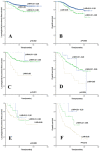Using the lymph nodal ratio to predict the risk of locoregional recurrence in lymph node-positive breast cancer patients treated with mastectomy without radiation therapy
- PMID: 23672513
- PMCID: PMC3691848
- DOI: 10.1186/1748-717X-8-119
Using the lymph nodal ratio to predict the risk of locoregional recurrence in lymph node-positive breast cancer patients treated with mastectomy without radiation therapy
Abstract
Background: To evaluate the prognostic value of axillary lymph node ratio (LNR) as compared to the number of involved nodes (pN stage) in patients with axillary lymph node-positive breast cancer treated with mastectomy without radiation.
Methods: We performed a retrospective analysis of the clinical data of patients with stage II-III node-positive breast cancer (N=1068) between 1998 and 2007. Locoregional recurrence-free survival (LRFS) and overall survival (OS) were compared based on the LNR and pN staging.
Results: A total of 780 cases were classified as pN1, 183 as pN2, and 105 as pN3. With respect to LNR, 690 cases had a LNR from 0.01-0.20, 269 cases a LNR from 0.21-0.65, and 109 cases a LNR > 0.65. The median follow-up time was 62 months. Univariate analysis showed that both LNR and pN stage were prognostic factors of LRFS and OS (p<0.05). Multivariate analysis indicated that LNR was an independent prognostic factor of LRFS and OS (p<0.05). pN stage had no significant effect on LRFS or OS (p>0.05). In subgroup analysis, the LNR identified groups of patients with different survival rates based on pN stage.
Conclusions: LNR is superior to pN staging as a prognostic factor in lymph node-positive breast cancer after mastectomy, and should be used as one of the indications for adjuvant radiation therapy.
Figures


References
Publication types
MeSH terms
LinkOut - more resources
Full Text Sources
Other Literature Sources
Medical
Miscellaneous

